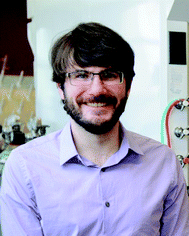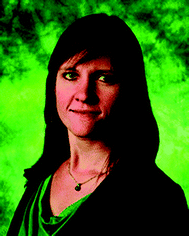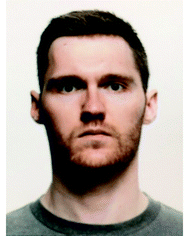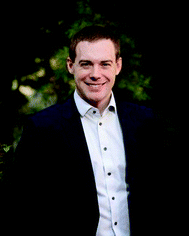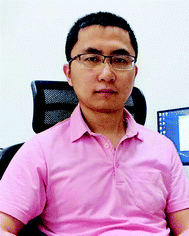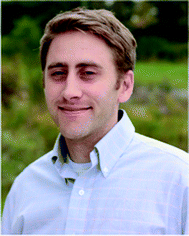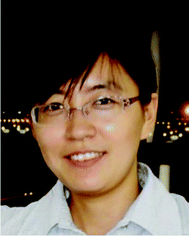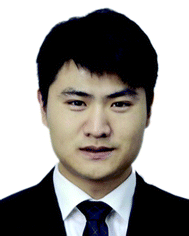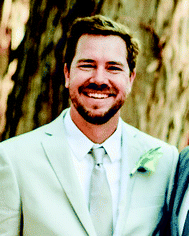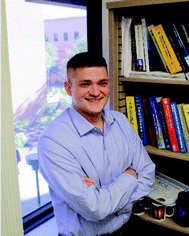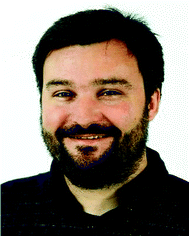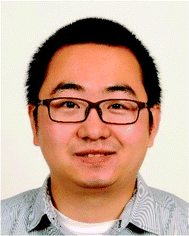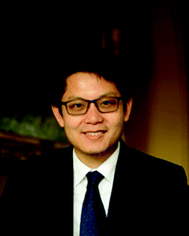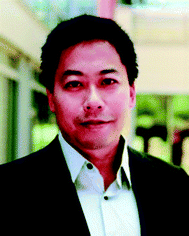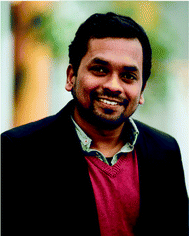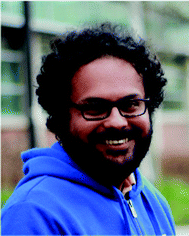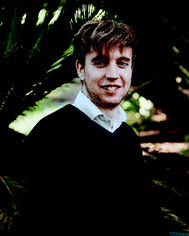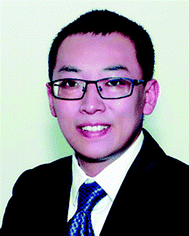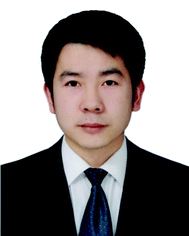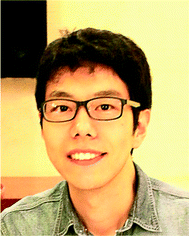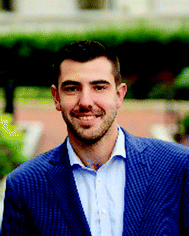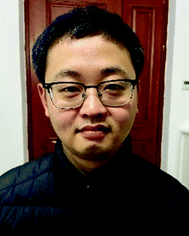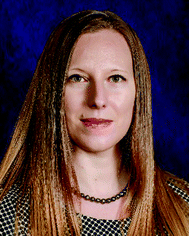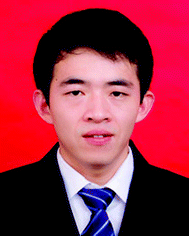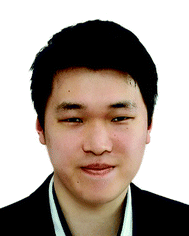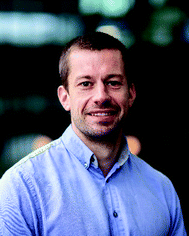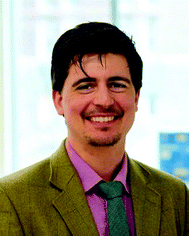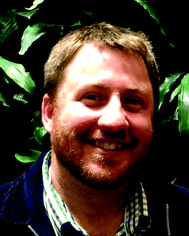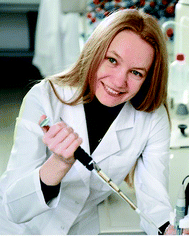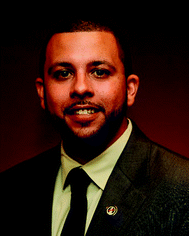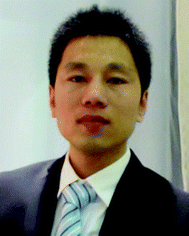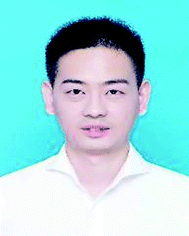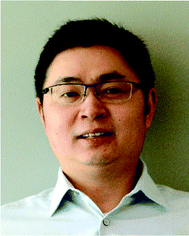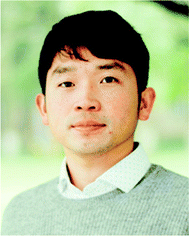Journal of Materials Chemistry C profiles: contributors to the Emerging Investigators 2020 issue
Our 2020 Emerging Investigators themed issues gather some of the best research being conducted by scientists in the early stages of their independent career. Each contributor was recommended as carrying out work with the potential to influence future directions in materials chemistry. Congratulations to all of the researchers featured, we hope you enjoy reading this issue.Dr Jared M. Allred is an Assistant Professor of chemistry at the University of Alabama. Before beginning this position in 2015, Dr Allred completed a three year postdoctoral appointment in the Neutron and X-ray Scattering Group in Argonne National Lab's Material Science Division. He received his BS in Chemistry from CWRU in 2007 and a PhD in solid state chemistry under the supervision of Robert J. Cava at Princeton University in 2012. Dr Allred received the DOE Early Career Award in 2017.
Dr Claudia Backes studied Molecular Nano Science at the University of Erlangen-Nuremberg, where she also conducted her doctoral studies under the supervision of Professor Andreas Hirsch. She received her PhD with honors in 2011. After having supported the Erlangen Cluster of Excellence for 1.5 years as deputy executive director, she received a fellowship grant from the German Research Foundation (DFG). In 2012, she moved to Jonathan Coleman's group at Trinity College Dublin, where her excitement for 2D materials started. In 2015, she returned to Germany and joined Heidelberg University. In 2016, she was awarded the prestigious DFG Emmy Noether funding to establish her own research group at the Physical Chemical Institute at Heidelberg University. Her research is in nanoscience at the interface between chemistry and physics focusing on the production and functionalisation of new nanomaterials.
Dr Diana Berman received her BS in Applied Physics and Math from Moscow Institute of Physics and Technology, and a PhD in Physics from North Carolina State University. Since 2012 she has worked as a postdoctoral researcher and then as a research associate at the Center for Nanoscale Materials at Argonne National Laboratory. In 2016 she joined the Materials Science and Engineering Department at the University of North Texas as an assistant professor. She is the author of more than 40 publications and 6 patents. She is a recipient of the University of North Texas Presidential Early Career Professorship Award, 2017 Ralph E. Powe Junior Faculty Enhancement Award, and TechConnect National Innovation Awards at the 2016 and 2017 TechConnect's annual World Innovation Conferences and Expo. Her research interests are in synthesis and characterization of nanostructures, surfaces, and interfaces of ceramic and carbon-based materials for the precise control and improvement of their physical properties and functionality.
Dr Lee Burton finished his PhD in the UK in 2014. He was subsequently awarded postdoctoral fellowships (to work in Japan and Belgium) and the European Seal of Excellence 2018. Now he is starting a group at Shanghai University supported by the National Science Foundation of China and the Shanghai Municipal Government. His work originally focused on materials for photovoltaics, transitioning to crystal structure prediction and, most recently, screening all known materials for applications from catalysis to hydrogen storage. Now he aims to use his expertise with big-data to incorporate machine learning into the process of property prediction and materials discovery.
Dr Scott Cushing is an assistant professor at the California Institute of Technology. Scott studied Physics and Material Science at West Virginia University under the supervision of Dr Nick Wu and Dr Alan Bristow. After being a DOE EERE postdoctoral fellow with Steven Leone at the University of California, Berkeley, Scott obtained his current position in 2018. Scott's research focuses on building instrumentation using optical and laser based technologies. His current research includes table-top pulsed X-ray sources, time resolved EELS spectroscopy, and applying entanglement to spectroscopy. The instruments are applied to questions ranging from renewable energy to molecular qubits to bioimaging.
Dr Tao Ding obtained his PhD majoring in physical chemistry at the Institute of Chemistry, Chinese Academy of Science (ICCAS) in 2011. He undertook postdoctoral work at Nanyang Technology University under the guidance of Professor Hongyu Chen (2011–2013). Afterwards, he joined the Nanophotonics Centre in the Cavendish Laboratory at Cambridge University, working with Professor Jeremy Baumberg. Tao was a Leverhulme Early Career Fellow before taking his tenure-track position at Wuhan University in 2017. He is now the head of the Photonic Materials and Technology (PMT) group with a major research focus on tuneable nano-optics, laser-directed materials growth, and colloidal plasmonics. The expertise of his group includes laser fabrication and microspectroscopy, aiming to address fundamental questions of light–matter interactions and related applications.
Dr Benjamin T. Diroll received his PhD in chemistry from the University of Pennsylvania (2015). Subsequently, he become a Director's Postdoctoral Fellow and then a scientific staff member at the Center for Nanoscale Materials at Argonne National Laboratory. His research interests include synthesis, self-assembly, optical properties, and device physics of semiconductor nanomaterials.
Dr Huanli Dong is a full Professor at the Institute of Chemistry, Chinese Academy of Sciences (ICCAS). She received her PhD in physical chemistry from ICCAS in 2009. Since then, she has worked at the Key Laboratory of Organic Solids at ICCAS. Her research interests focus on organic/polymeric semiconductors and their applications in field-effect transistors, light-emitting transistors, and their integration. She is also interested in crystalline conjugated polymers with 1D and 2D conjugation and their applications in fundamental studies and optoelectronic devices. So far, she has published more than 210 peer-reviewed papers with over 9100 citations.
Dr Renhao Dong is an independent research group leader (TUD Young Investigator) at the Center for Advancing Electronics Dresden (cfaed) and Faculty of Chemistry and Food Chemistry, Technische Universität Dresden. He received his Bachelor's degree in chemistry in 2008 and then doctor's degree in colloid and interface chemistry in 2013 at Shandong University (Jinan, China). He joined the Max Planck Institute for Polymer Research (Mainz, Germany) as a research associate in July 2013. In January 2017, he was appointed as a research group leader of organic 2D materials in the Chair for Molecular Functional Materials at TUD. His current scientific interests include (1) design and synthesis of topological π-conjugated molecules; (2) chemistry of 2D conjugated polymers and functions for electronics; (3) conductive COFs and MOFs for opto-electronics, magnetics, electrocatalysis, energy storage and sensing; (4) novel van der Waals and lateral heterostructures and their exotic physical and chemical properties.
Dr James A. Dorman is an assistant professor in Chemical Engineering at Louisiana State University (LSU). His group focuses on the synthesis of hierarchical metal oxide nanostructures and their unique optical/electronic properties, and surface chemistry. Prior to joining LSU, James was an Alexander von Humboldt research fellow at Konstanz University in Germany where he worked on the optimization of next generation solar cells by charge separation and transport across hybrid interfaces. He received his PhD from the University of California Los Angeles in 2012, focusing on engineering energy transfer between rare-earth dopants, and his BS from the University of California San Diego, both of which were in chemical engineering.
Dr Eric Daniel Głowacki studied materials chemistry at the University of Rochester, graduating in 2009. He completed his PhD in 2013 at the Johannes Kepler University, Linz, on bioelectronic semiconductors and soft electronic devices, followed by a postdoctoral stay continuing in these topics. In 2015, he was appointed assistant professor of physical chemistry. In 2017, he moved his research group, working on implantable biomedical and bioelectronic devices, to Linköping University, as a Wallenberg Centre for Molecular Medicine fellow. His main research interests concern using near-infrared optical methods for neuromodulation, and the biophysics of reactive oxygen species like peroxide.
Dr Matthew Green joined the faculty at Arizona State University in 2014 after completing a PhD in chemical engineering at Virginia Tech, and a postdoc at the University of Delaware in the chemical and biomolecular engineering department. His training as a synthetic polymer chemist and chemical engineer, positions his research group at the critical intersection of the disciplines of health, the environment, and advanced materials. His laboratory is integrating macromolecular design with controlled synthesis techniques to produce hierarchical and multifunctional materials that manipulate the interdependence of electrostatic interactions, microstructure, thermomechanical properties, and transport. These features can tune the material properties for applications such as membranes for water purification, CO2 capture, or polymeric nanocomposites.
Dr Felix Gunkel is a young physicist who received his PhD from RWTH Aachen University. He established his profile as a postdoctoral researcher at Peter Gruenberg Institute, Forschungszentrum Juelich, SLAC/Stanford University, and RWTH Aachen University. From 2015 he headed a research group at RWTH Aachen, and since 2019 at the Peter Gruenberg Institute to explore the redox-behavior of functional oxide interfaces and surfaces. Currently, he is a H. C. Ørsted-Fellow at DTU Energy in Denmark. Felix’s research exploits the atomically defined epitaxy of oxide heterostructures and the thermodynamic understanding of their redox-behavior. His research aims at functionalizing confined ionic defects for nanoelectronics and energy conversion.
Dr Bo Hou is a Lecturer at the School of Physics and Astronomy, Cardiff University. He obtained his PhD in physical chemistry from the University of Bristol in early 2014, where he studied the semiconductor photo-electrochemistry and microstructure analysis of colloidal quantum dots (QD). He then worked as a postdoctoral research assistant at the University of Oxford (2014–2018), and was a senior research fellow at the University of Cambridge (2018–2020). His research interests include QD synthesis, QD optoelectronics, electron microscopy (TEM) and dynamic charge transfer analysis.
Dr Robert Hoye is a lecturer (assistant professor) in the Department of Materials at Imperial College London. There, he also holds the Royal Academy of Engineering Research Fellowship. He completed his PhD at the University of Cambridge (2012–2014), before taking up a postdoctoral position at the Massachusetts Institute of Technology (2015–2016). Subsequently, he took up two independent Research Fellowships at Cambridge, firstly at Magdalene College (2016–2019) then at Downing College (2019–2020). He moved to set up his group at Imperial in 2020. His research focuses on optoelectronic materials development, particularly on defect-tolerant semiconductors for photovoltaics.
Dr Yongjie Hu is an assistant professor at the School of Engineering and Applied Science, University of California, Los Angeles (UCLA). His group exploits interdisciplinary experimental and theoretical approaches to investigate energy transport mechanisms and device applications, with a current emphasis on developing advanced materials and experimental metrologies to characterize nanoscale energy processes. Before joining the faculty of UCLA, he received his PhD degree from Harvard University, and postdoctoral fellowship from Massachusetts Institute of Technology. His research has been recognized by diverse research societies through their awards including the Alfred P. Sloan Research Fellowship, the ASME Bergles-Rohsenow Young Investigator Award, the National Science Foundation's CAREER Award, and the U.S. Air Force Young Investigator Award.
Dr Imalka Jayawardena is the Marcus Lee Lecturer at the Advanced Technology Institute at the University of Surrey. His research focuses on the development of multijunction solar cells based on perovskites, developing new detectors for medical imaging and radiation dosimetry and understanding radiation damage in materials. He received his PhD from the University of Surrey working on gas sensors, and his BSc (Hons) in Engineering from the University of Moratuwa. Following his PhD, he has worked on organic and perovskite photovoltaics (supported by the EPSRC Doctoral Prize award) and also organic–inorganic hybrid X-ray sensors.
Dr Ajay Ram Srimath Kandada is an assistant professor of physics at Wake Forest University. He received a PhD in physics from Politecnico di Milano in 2013 under the supervision of Professor Guglielmo Lanzani, and he was a post-doctoral researcher at IIT Milano between 2013 and 2016. He was a Marie Sklodowska Curie global fellow from 2016 to 2018 in the group of Professor Carlos Silva at the University of Montreal, and later at the Georgia Institute of Technology. His research interests include the investigation of electronic properties of emerging materials via non-linear optical spectroscopy and quantum-optical methodologies.
Dr John Labram received his undergraduate degree in physics from the University of Warwick in 2008, and his PhD in physics from Imperial College London in 2011, the latter under the supervision of Thomas Anthopoulos. In 2014 John joined the Materials Science Department at the University of California Santa Barbara as a postdoctoral fellow, working under Michael Chabinyc. Since 2017 John has been an assistant professor at the School of Electrical Engineering and Computer Science at Oregon State University. John's research interests include solution-processed semiconductors, thin film devices, electronic properties of materials, and contactless microwave conductivity.
Dr Guijun Li received his BSc in physics from Nanjing University, and PhD in electrical and electronic engineering from the University of Hong Kong. Currently, he is a research assistant professor at the State Key Laboratory of Ultra-Precision Machining Technology, Department of Industrial and Systems Engineering at Hong Kong Polytechnic University. He is a senior member of IEEE, and an associate editor of IEEE Access. He has research interests in optics and magnetics. Currently he is focusing on developing digital manufacturing methods to process functional materials for healthcare and energy applications.
Dr Pengcheng Li is an associate professor of Wuhan Institute of Technology (WIT). He received his Bachelor degree majoring in applied chemistry from Wuhan University (WHU) in June 2008, and PhD degree from Changchun Institute of Applied Chemistry, Chinese Academy of Sciences (CAS) in January 2014. After completing his postdoctoral training at the National University of Singapore (NUS), he joined the School of Materials Science and Engineering, Wuhan Institute of Technology in September 2017. His research interests focus on stretchable and flexible conducting polymers and composites, and their application in energy harvesting and flexible electronic devices.
Dr Tao Li is an associate professor in the School of Chemistry and Chemical Engineering, Shanghai Jiao Tong University. He obtained his PhD degree from the Institute of Chemistry, Chinese Academy of Sciences in 2010. Then he joined the University of Copenhagen as a postdoctoral fellow. In 2013, he was appointed to the position of assistant professor in the Department of Chemistry, University of Copenhagen. He started his own group in Shanghai Jiao Tong University in 2015. His current research mainly focuses on the design and synthesis of new optoelectronic molecules, and the fabrication of multiscale organic functional devices.
Dr Steven Lopez obtained his PhD working with Ken Houk at the University of California, Los Angeles, in 2015 and was a DOE EERE postdoctoral fellow with Alan Aspuru-Guzik at Harvard from 2015–2017. Steven is now an assistant professor of chemistry at Northeastern University. His research group is focused on identifying new “green” reactions and sustainable materials for solar energy harvesting using multireference computations and machine learning techniques. He collaborates with experimentalists to verify predictions to understand reactivities and stereoselectivities of photochemical transformations. He is also the director of the Alliance for Diversity in Science and Engineering (ADSE) and advises the ADSE@NU local chapter.
Dr Yun Ma received his BSc degree in polymer materials and engineering at Qingdao University in 2008. Dr Ma earned his Master's degree in materials science from Nanjing University of Posts and Telecommunications in 2012, and his PhD degree in chemistry from Hong Kong Baptist University in 2015. In 2016, he joined Nanjing University of Posts and Telecommunications as an associate professor. His research interests focus on the development of novel stimuli-responsive materials for chemical sensing, rewritable information recording, data encryption and decryption, and anti-counterfeiting.
Dr Noa Marom is an assistant professor of materials science and engineering at Carnegie Mellon University with courtesy appointments in the Department of Chemistry and the Department of Physics. She received a BA in physics and a BS in materials engineering, both cum laude, from the Technion-Israel Institute of Technology in 2003. From 2002 to 2004 she worked as an application engineer in the Process Development and Control Division of Applied Materials. In 2010 she received a PhD in chemistry from the Weizmann Institute of Science. She was awarded the Shimon Reich Memorial Prize of Excellence for her thesis. From 2010 to 2013 she pursued postdoctoral research at the Institute for Computational Engineering and Sciences (ICES) at the University of Texas at Austin. From 2013 to 2016 she was an assistant professor of physics at Tulane University. She has received an NSF CAREER Award, a Charles E. Kaufman Young Investigator award, and the IUPAP Young Scientist Prize in Computational Physics. Her group combines quantum mechanical simulations with machine learning and optimization algorithms to discover and design materials for various applications.
Dr Zhengong Meng obtained his PhD degree under the tutelage of Professor Wai-Yeung Wong in 2016 at Hong Kong Baptist University. He is currently a research associate professor at Shenzhen University. His research focuses on organometallic chemistry, aiming at developing metal–organic molecules and polymers for metal-based nanomaterials such as iron-based magnetic nanoparticles, etc.
Dr Min Hyuk Park received his BS and PhD degrees in materials science and engineering from Seoul National University, Seoul, Korea, in 2008 and 2014, respectively. He worked as a postdoc at Seoul National University (2014–2015) and NaMLab gGmbH in Dresden Germany (2015–2018) as a Dresden Junior Fellow and a Humboldt Postdoctoral Fellow. He is currently an assistant professor at the school of materials science and engineering of Pusan National University since 2018, and he was nominated as 2020 POSCO Science Fellow supported by the POSCO TJ Park Foundation. His research interests include ferroelectric and antiferroelectric thin films for memory, energy storage, energy harvesting, solid-state cooling, and sensor applications. He has coauthored more than 65 papers in peer-reviewed journals and 9 book chapters.
Dr Joe Patterson is an assistant professor in the Chemistry Department at the University of California Irvine. He completed his PhD in polymer chemistry and self-assembly at the University of Warwick, working under the supervision of Professor Rachel O’Reilly. He performed postdoctoral research at the University of California San Diego with Professor's Nathan Gianneschi and Kimberly Prather. In 2016 he joined the Eindhoven University of Technology, working in the Laboratory of Materials and Interface Chemistry with Professor Nico Sommerdijk. His interests involve the development of new materials through a deep understanding of their structural dynamics. To address challenges in this area he has formed a close collaboration with DENSsolutions on Liquid Phase Electron Microscopy.
Dr Michael Ruggiero is an assistant professor of chemistry and materials science at the University of Vermont. He obtained his BSc in chemistry at SUNY Geneseo, followed by his MPhil and PhD at Syracuse University, which focused on understanding the nature of terahertz vibrational motions. He was a postdoctoral fellow at the University of Cambridge, where he furthered his work in low-frequency vibrational spectroscopy. His current research is devoted to understanding the link between terahertz vibrations and material functions. When out of the lab, he can typically be found wandering around the Green Mountains of Vermont.
Dr Kevin Stamplecoskie is an assistant professor in the Department of Chemistry at Queen's University. Trained as a photochemist (PhD at the University of Ottawa with Professor J. C. Scaiano, and postdoctoral research at the University of Notre Dame with Professor Prashant Kamat), Stamplecoskie's research on synthesizing metal materials has a strong focus on the tunable/controllable synthesis of metal particles toward desired optical/electronic properties. His group aims to engineer new photonic materials and composites to advance the areas of chemical sensing, optical computing, photocatalysis, and biomedicine.
Dr Elena Sturm (née Rosseeva) is a group leader at the Department of Physical Chemistry at the University of Konstanz (host: the group of Professor H. Cölfen) and also a Fellow of the “Zukunftskolleg”. She received her PhD from the Department of Crystallography at Saint-Petersburg State University in 2010 under the supervision of Professor O. V. Frank-Kamenetskaya and Professor R. Kniep (MPI CPfS in Dresden). From 2010 to 2012 she was a postdoc at MPI CPfS. The basic philosophy driving her research work is to get a deeper insight into the fundamental principles of structuring, formation and functioning of complex and unique nanostructured composite materials from biological hard tissues, biomimetic and bioinspired materials and nanoparticle assemblies.
Dr Jesús M. Velázquez received a BS in chemistry from the University of Puerto Rico, Cayey in 2004 before working as a chemist in pharmaceutical industries until 2007. In 2012 he received a PhD in chemistry from SUNY-Buffalo under the supervision of Professor Sarbajit Banerjee and began working as an NRC Ford Foundation Postdoctoral Fellow at the California Institute of Technology under the mentorship of Professor Nathan S. Lewis. He has received several awards while at the University of California, Davis, including a CAMPOS Faculty Scholar (2016), Scialog Fellow in Advanced Energy Storage (2017), as well as the Cottrell Scholar Award (2020).
Dr Guohua Xie obtained his PhD degree in microelectronics and solid-state electronics from Jilin University in 2011. From 2011 to 2012, he was supported by the Alexander von Humboldt Foundation to carry out postdoctoral research on organic light-emitting devices at TU Dresden and Fraunhofer COMEDD. Since January 2013, he has worked for an interdisciplinary project at the Organic Semiconductor Center at the University of St Andrews. He has been serving as an associate professor at the College of Chemistry and Molecular Sciences of Wuhan University since January 2015. Dr Xie focuses on the interdisciplinary research of organic semiconductors.
Dr Jie Yang, born in 1991, received his BS and PhD degree from Wuhan University under the supervision of Professor Zhen Li in 2013 and 2018, respectively. Then he joined Tianjin University (TJU) in July of 2018 as a lecturer. His research interests mainly focus on the design and synthesis of new organic luminescent materials, including aggregation-induced emission (AIE), mechanoluminescence (ML) and room temperature phosphorescence (RTP). He has about 20 publications as the first or corresponding author, including in Nat. Commun., Angew. Chem., Int. Ed., Chem. Sci., J. Mater. Chem. C and so on.
Dr Cunjiang Yu is the Bill D. Cook Associate Professor in the Department of Mechanical Engineering at the University of Houston. He also holds joint appointments in the Electrical and Computer Engineering, Biomedical Engineering, and Materials Science and Engineering Department. He obtained his BS in mechanical engineering and MS in electrical engineering in 2004 and 2007, respectively, from Southeast University, Nanjing. He received his PhD degree in mechanical engineering from Arizona State University in 2010. He was a post-doctoral fellow in the Department of Materials Science and Engineering at the University of Illinois at Urbana-Champaign from 2010–2013. His research focuses on the fundamental and application aspects of flexible and stretchable electronics, and bioelectronics. Dr Yu is a recipient of the NSF CAREER Award, ONR Young Investigator Award, MIT Technology Review Inaugural Chinese Top Innovators, SME Outstanding Young Manufacturing Engineer Award, AVS Young Investigator Award, ACS Petroleum Research Fund Doctoral New Investigator Award, and 3M Non-Tenured Faculty Award, etc. His recent research has been reported or highlighted by many media outlets, such as Time, Discovery, BBC News, NBC News, Science News, USA Today, etc.
Dr Yonghao Zheng received his MChem (2008) and PhD (2011) degrees from Durham University, where the dissertation work was done under the supervision of Professor Martin R. Bryce. He spent two periods of time (2012–2014 and 2016) in Professor Fred Wudl's group at the University of California Santa Barbara as a postdoctoral researcher. In 2015, he moved to Rice University as a postdoctoral researcher in Professor James M. Tour's group. In 2016, he became a professor at the University of Electronic Science and Technology of China (UESTC). His current research is mainly focused on the development of functional organic materials (stable radicals and responsive molecules), and the exploration of their applications in single-molecule devices and sensors.
| This journal is © The Royal Society of Chemistry 2020 |

